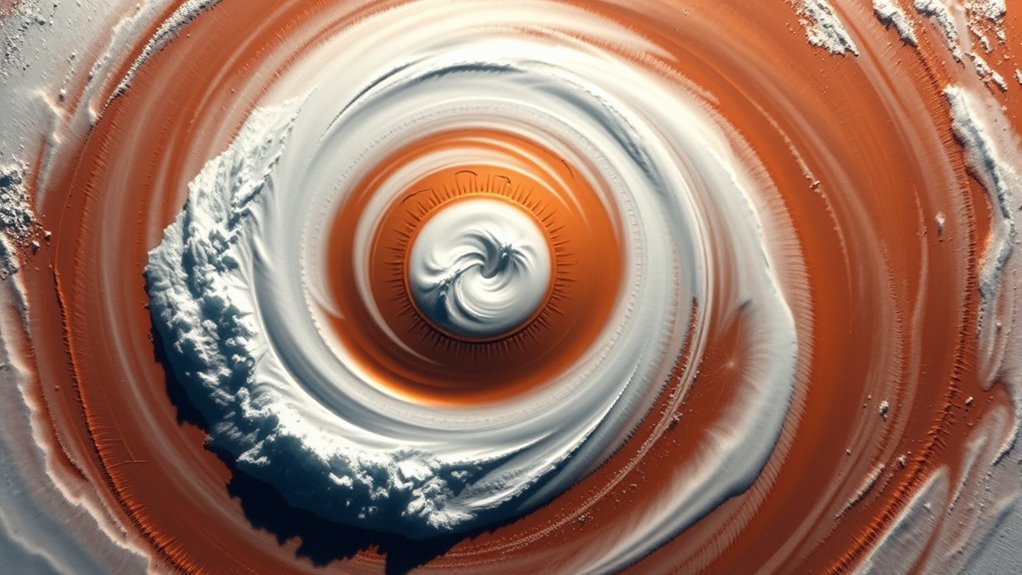You’ll see that the Mars polar vortex is a powerful, long-lasting feature that creates extreme cold over the planet’s poles. It circulates cold, dense air, trapping ozone and preventing it from dispersing. This vortex influences seasonal climate, causing temperatures to drop hundreds of degrees, and helps form the polar caps. Its behavior reveals much about Mars’s atmosphere and chemistry, offering fascinating clues if you explore further into these atmospheric phenomena.
Key Takeaways
- The Mars polar vortex is a persistent cyclone that isolates the polar region with cold, dense air during winter months.
- It causes extreme surface temperatures, sometimes hundreds of degrees below freezing, influencing seasonal ice cap growth.
- The vortex traps ozone molecules, leading to localized ozone accumulation and fluctuations related to atmospheric cycles.
- Cold temperatures within the vortex drive chemical reactions that generate or destroy ozone, affecting atmospheric chemistry.
- Studying the vortex reveals insights into Mars’s climate, temperature extremes, and the dynamics of its thin atmosphere.

A polar vortex on Mars is a large-scale atmospheric phenomenon where cold, dense air circulates around the planet’s poles, creating a persistent and powerful cyclone. Unlike Earth’s vortex, which is driven largely by water vapor and oceanic interactions, Mars’s vortex is shaped by its thin atmosphere and extreme temperature differences. During the winter months, the cold air becomes even more concentrated, sinking toward the surface and fueling the vortex’s strength. As you observe this process, you’ll notice how the vortex acts like a giant, swirling barrier, isolating the polar region from the rest of the atmosphere. This containment prevents warmer air from mixing with the cold polar air, intensifying the temperature contrast. The vortex can last for weeks or even months, depending on seasonal and atmospheric conditions, and its presence plays a vital role in the climate and atmospheric chemistry on Mars.
As the vortex persists, it plays a pivotal role in ozone dynamics over the planet. You might find it surprising that Mars, which lacks a substantial ozone layer like Earth, still exhibits ozone variations. During the vortex’s peak, ozone tends to accumulate within the polar region, creating localized pockets of higher concentration. This buildup occurs because the vortex traps ozone molecules, preventing them from dispersing into other parts of the atmosphere. The cold temperatures within the vortex also facilitate chemical reactions that generate or destroy ozone, making the atmospheric chemistry more complex. Scientists have observed that ozone levels fluctuate with the vortex’s strength and position, providing valuable insights into Mars’s atmospheric processes.
The extreme cold inside the vortex reaches temperatures that are rarely seen elsewhere on the planet. You might imagine that the temperature drop is immense, plunging hundreds of degrees below freezing, which causes carbon dioxide gas to freeze out of the atmosphere and form seasonal polar caps. These caps grow larger as winter progresses, reinforcing the vortex’s stability. The cold temperatures also influence the formation of dust storms, which can get trapped within or around the vortex, affecting local weather patterns. Understanding these interactions helps scientists piece together how Mars’s atmosphere responds to seasonal changes and why certain phenomena, like the vortex, are so persistent. Additionally, the presence of vortex-driven ozone variations offers clues about the chemical processes occurring in the Martian atmosphere.
Frequently Asked Questions
How Long Does the Polar Vortex Typically Last on Mars?
You’ll find that the polar vortex on Mars usually lasts about a few weeks to a couple of months, depending on the season. During winter, it forms as cold air sinks and creates a stable, intense vortex. As temperatures rise with the changing seasons, the vortex gradually dissipates. You can expect this cycle to repeat annually, with the vortex’s duration influenced by atmospheric and seasonal factors.
What Impact Does the Vortex Have on Potential Human Exploration?
The vortex can greatly hinder your exploration plans by causing extreme cold and unpredictable weather. Imagine you’re testing new equipment when sudden temperature drops threaten your mission’s success. The ozone buildup worsens the environment, increasing health risks and complicating atmospheric analysis. You’ll need advanced insulation, reliable weather forecasting, and robust systems to guarantee safety and mission continuity during these intense polar vortex events.
Are There Any Signs of Life Affected by the Vortex Conditions?
You won’t find clear signs of life affected by the vortex conditions on Mars. The extreme cold and ozone buildup create a harsh environment that likely limits any existing microbial life. If you’re exploring, you’d notice these conditions make survival challenging for organisms, especially near the poles. While some microbial life might persist underground, the vortex’s impact mainly shapes the planet’s atmosphere and surface, not directly influencing potential life forms.
How Does Mars’ Atmosphere Compare to Earth’s During Vortex Events?
During vortex events, Mars’ atmosphere becomes much colder and thinner than Earth’s. You’ll notice that the temperature drops markedly, and the ozone layer, although much less developed, can become more concentrated locally. Unlike Earth, Mars lacks a substantial water cycle and weather systems, so these vortices mainly cause temperature fluctuations and ozone build-up rather than storm activity. You’d see a stark contrast in atmospheric dynamics between the two planets during such events.
Can the Vortex Influence Mars’ Overall Climate or Weather Patterns?
Yes, the vortex can influence Mars’ overall climate and weather patterns. You’ll notice that during vortex events, the temperature drops considerably and dust gets trapped, affecting surface conditions. These phenomena can alter wind patterns and atmospheric circulation, leading to shifts that impact the planet’s climate over time. While the effects are less dramatic than on Earth, they still play an essential role in shaping Mars’ atmospheric behavior.
Conclusion
So, as you see, the polar vortex on Mars brings extreme cold and unexpected ozone buildup, revealing just how dynamic the Red Planet’s atmosphere can be. Isn’t it fascinating to think about what these atmospheric changes mean for future exploration? With each discovery, you get closer to understanding Mars’s secrets. Stay curious, because the more we learn, the more mysteries we can unravel about our neighboring planet. Who knows what surprises Mars still has in store?









